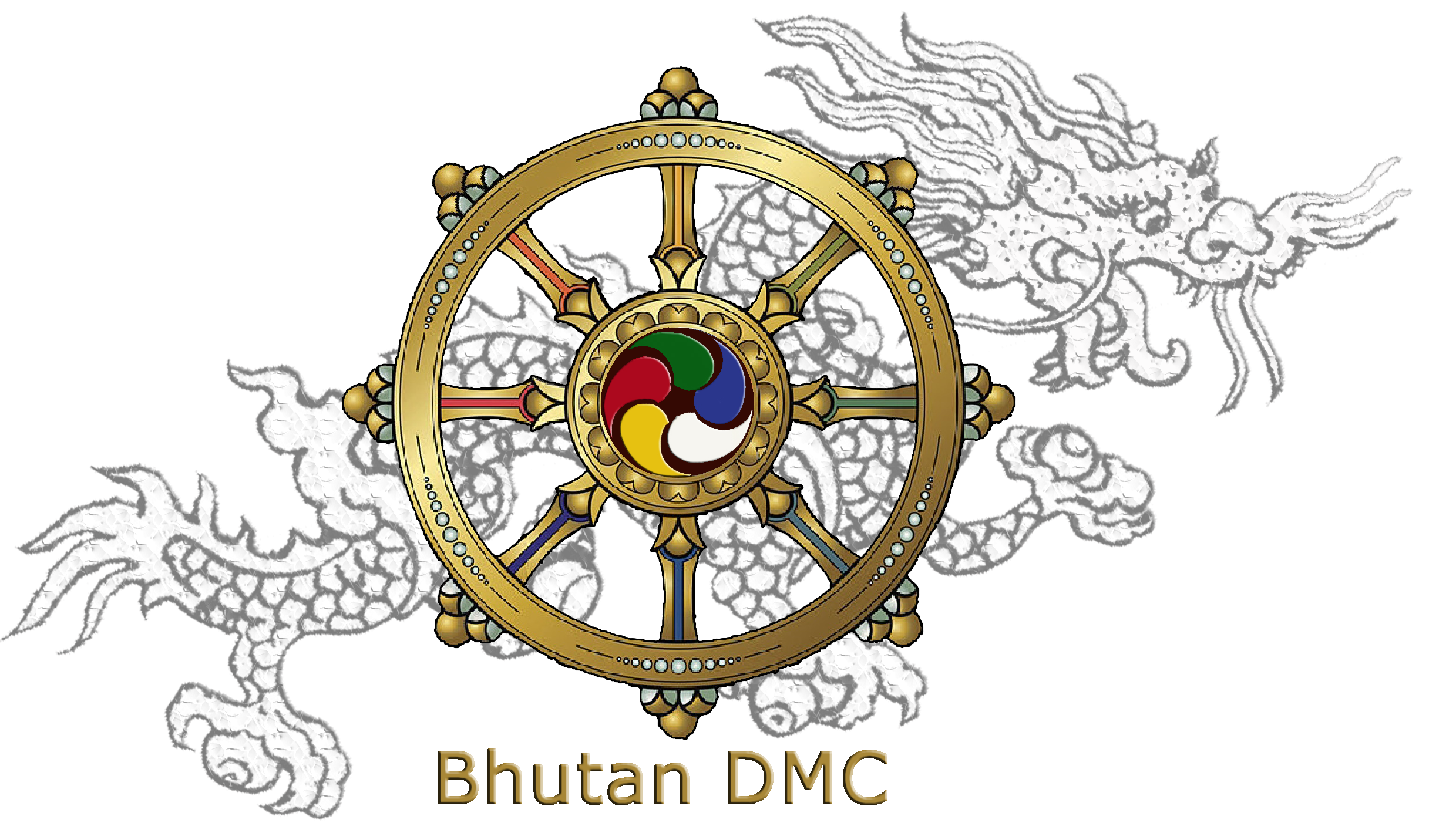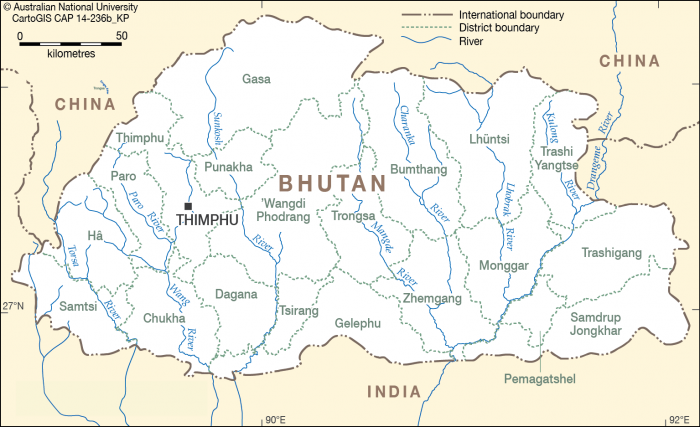Bhutan is rightly known to the world today as the last Shangri-La. If there is a place on earth that even the most seasoned travelers consider a privilege to visit, it is indeed BHUTAN. The few lucky visitors, who make the lifetime journey to this extraordinary land, realize that there is no other destination like this land of pure and exotic mysticism.
It was the mighty Himalayas that protected Bhutan from the rest of the world and left this Himalayan Jewel blissfully untouched. The Drukpa Kagyupa sect of Mahayana Buddhism provided the essence of a rich culture and fascinating history. The Bhutanese people protected this sacred heritage and unique identity for centuries by choosing to remain in a jealously guarded isolation.
Druk Yul or the ‘Land of Thunder Dragon’ as referred by its natives, the princely Kingdom of Bhutan is a landlocked country, encompassing an area of 38,394 square kilometers. Located between longitude 88045’ and 92010’ East and latitudes 26040’ and 28015’ North in the Eastern Himalayas, it is bordered by India in South and South-West and Tibetan autonomous region of China in the North and North-West respectively. Virtually the entire country is mountaineous, and ranges in elevation from 240m along the Indian border to the 7,554m, Kulha Gangri peak on the Tibetan border. These two extremes frame a landscape which stretches from sub-tropical to arctic like conditions.
With a relatively small population of 7,35,553 people, the Bhutanese enjoy a sustainable lifestyle which they inherited from their forefathers. Bhutan’s population is, in many ways, one large family. About 70 percent of the people still live on subsistence farming, scattered in sparsely populated villages, across the rugged terrain of the Himalayas. Buddhism, prevalent in the country since the 7th century, continues to play an important role in their peaceful lives.
Having always been politically independent, a rich and distinctive culture developed in the country over the ages. Perhaps the most important single factor in the molding of Bhutanese character and thought has been the teaching of Lord Buddha, whose eternal truths were first brought into the country from Tibet over the high, snow-bound mountain passes by the great Indian saint, Guru Padsambhava.
Bhutan is the last bastion of Vajrayana Buddhism, a spiritual practice that is known to be one of the most profound schools of teaching in the Buddhist world. The sacred monasteries that sit precariously on sheer cliffs, the fluttering prayer flags that line the high ridges, the red-robed monks who chant through the day and night, give this Kingdom an aura that comes from another time.
All Bhutanese art, dance, drama and music has its roots in the Buddhist religion. And this Buddhist art has a much different purpose from other contemporary art, being more subjective, symbolic and impersonal. Unlike many other countries, arts, ceremonies and festivals of Bhutan are not remnants of a bygone age but they are still practiced and performed because they continue to have religious and spiritual significance and they are the manifestation of a living culture.
Festivals in the Land of Thunder Dragon are rich and happy expressions of its ancient Buddhist culture. These festivals are held in all districts in honour of Guru Rinpoche, the saint who introduced Buddhism to Bhutan in the 8th century. Tshechu (festivals) are held on auspicious days and months in the Bhutanese calendar, and last up to five days in which a series of highly stylized masked dance rituals are performed.
The raw and natural beauty of the earth characterizes much of Bhutan’s environment that has made it so stunning and captivating to visitors. From the tropical plains right up to the alpine highlands, Bhutan’s environment is so diverse as its culture. The Land of the thunder Dragon is, today, one of the worlds top ten global hotspots, boasting a rich and varied biodiversity.
It is no surprise that the main goal in life for the Bhutanese people is happiness. Even the mandate of the modern Bhutanese state is Gross National Happiness. In translation, this means that economic development, a goal for much of humanity, is only a means to the real goal of happiness.
Bhutan is possibly one of the best samples of sustainable eco-tourism and one country that is committed to this concept, inspired by the Buddhist view of the interdependence between man and nature. Expressed in the unique development philosophy – Gross National Happiness – the national policy of high value, low volume tourism asks every visitor to be sensitive to a social, cultural, and environmental system that is trying to preserve the best of its traditions in a rapidly changing world. The government is determined to safeguard its heritage to ensure that the people maintain their dignity against the onslaught of globalization and modernization. The Bhutanese tourism industry is truly based on principle of sustainability that is ‘tourism must be environmentally and ecologically friendly, socially and culturally acceptable and economically viable’.
Country profile
Altitude: between 240metres and 7554metres above sea level
Language: ‘Dzongkha’ | English widely spoken
Religion: Vajrayana stream of Mahayana Buddhism or Tantric Buddhism
Currency: Ngultrum (equivalent to Indian Rupee)
Life expectancy: 70.2 years (2017)
Literacy rate: 71.4% (2017)
Country code: +975
Local time: GMT +6 | half an hour ahead of Indian Standard Time
National Game – Archery
Archery was declared national sport in 1971 when Bhutan became a member of United Nations. Archery tournaments are among the most picturesque and colourful events in the country. During Ancient times Archery was practiced with traditional bow and arrow (made out of Bamboo) by men. Two targets used to be set at an approximate distance of 120 metres. While men play the game, women rejoice watching the sports. These days most archers use compound bow and arrows.
National Animal – Takin
Takin (Burdoreastaxi color) – is associated with Bhutan’s religious history and mythology. It is a very rare mammal with a thick neck and short muscular legs. Takin lives in groups and is found above 4000meters on the north and western and also some eastern parts of the country. They feed on bamboo. The adult Takin can weigh over 200kgs.
National Flower – Blue Poppy
It is a delicate blue or purple tinged blossom with a white filament. Blue Poppy grows to a height of 1meter and is found above the tree line (3500-4500m) on rocky mountain terrain. It was discovered in 1933 by British Botanist George Sherrigg in a remote part of Sakteng in Eastern Bhutan.
National Flag
The upper yellow half signifies the secular power and authority of the King, while the lower saffron orange symbolizes the practice of religion and the power of Buddhism, manifested in the tradition of Drukpa Kagyu. The dragon signifies name and purity of country, while the jewels in its claws stand for the wealth and perfection of the country.
National Anthem
The national anthem was first composed in 1953 and became official in 1966. It is known as Druk Tshenden Kepay Gyalkhab Na (In the land of the Dragon Kingdom, where cypress grows). It is religious in essence with lyrics consisting of prayers for peace and prosperity in the country, long life of the King and propagation of Buddhism.
National Emblem
There is a Jewel on all sides with two Dragon on the vertical sides. The thunder bolts represent the harmony between secular and religious power while the Lotus symbolize purity. The jewel symbolizes the sovereign power while the dragons (male and female) represents the name of the country-DRUK YUL.
National Bird – Raven
It adorns the Royal Crown. The raven represents the Tutelary deity Gonpo Jarongdongchen, one of the chief guardian deities of Bhutan.
National Tree – Cypress
Found in abundance and it is a notable fact that large cypress trees are found near temples and monasteries. This tree is found in the temperate climate zone, between 1800 and 3500 m. Its capacity to survive on rugged harsh terrain is compared to bravery and simplicity.
National Day
17th December is celebrated as the National Day that coincides with the crowing of Gongpa Ugyen Wangchuk as the first hereditary King of Bhutan, in Punakha Dzong on 17 December,1907.
National Language
The state language is Dzongkha which in the olden times was spoken by people who worked in the Dzongs that was seat of temporal and spiritual power. Later, Dzongkha was declared as national language of the country. Today, about 18 languages and dialects spoken all over the country.
National Dress
The national dress of Bhutan is called the ‘Gho’ for men and ‘Kira’ for women. It was introduced during the 17th century by Zhabdrung Ngawang Namgyal to give the Bhutanese a unique identity. The gho is a long robe hoisted to the knee and held in place with a ‘Kera,’ a woven cloth belt, wound tightly around the waist. The kira is a floor-length rectangular piece of cloth wrapped around the body over a blouse called wonju. The kira is held from the shoulders by broach-like hooks called ‘Koma’ and is fastened at the waist with a kera. The dress is complete with a short, open jacket-like garment called ‘Toego.‘

